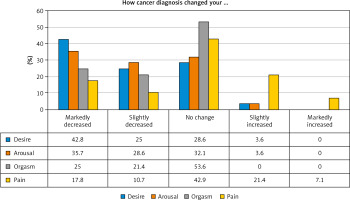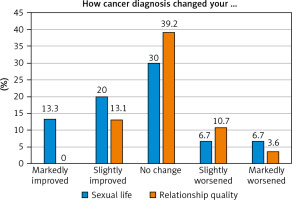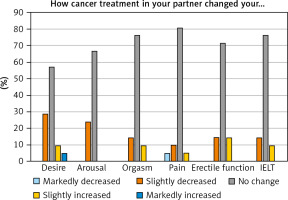Introduction
Deterioration of sexual health in gynaecological cancer survivors (ovarian, endometrial, cervical) has been well described [1–14]. The treatment of malignancies originating from sexual organs has short and long-term effects on different aspects of physical, psychological, and social functioning that can interfere with normal sexual function, body image, and sexuality [1, 15]. These effects include premature menopause, pain, depression, anxiety, fatigue and sleep disruption, change in weight (gain or reduction), scars, loss of skin sensation, loss of bowel and bladder function (formation of ostomies), lymphoedema, changes in social roles, and relationship disturbances or social isolation due to disabilities related to cancer treatment (like ostomy) [1–5].
Although 9–90% of women after treatment remain sexually active, the frequency of sexual problems in this population is high: dyspareunia or pain – 40–100%, vaginal dryness – 60–87%, loss of libido or low arousal – 25–61%, and low/lack of orgasm – up to 45% [6, 7, 16]. Most studied revealed that, compared with healthy women, those patients have greater problems with loss of desire and poorer sexual function scores, report abrupt shifts in self-identity due to loss of physical integrity, distancing in intimate relationships, changes in perceiving oneself as a sexual being, loss of sexual interest, and difficulties in mutual communication with a partner [2, 8–13, 17, 18].
Three main domains of sexual health have recently been described, including physical sexual function, sexual self-schema/body image, and sexual relationship [9, 19–21]. For that reason, sexual rehabilitation during cancer treatment should not focus just on coital frequency, but rather should include other aspects of human sexuality as a broader concept of psychosexual wellbeing [22, 23]. It is of great importance that positive sexual self-schema might facilitate adjustment to new life after a cancer diagnosis [24 , 25], and body image disturbances correlate with sexual distress [26].
Different patterns of sexual rehabilitation process exist. However, the understanding of factors that may influence once’s sexual adjustment to gynaecological cancer is always essential [27]. It is important in cases of survivors with or without a partner. It has been proven that support received from a partner have a positive effect on the rehabilitation process in breast cancer survivors [23] and that having a sexual partner correlates with better sexual function and psychological well-being in postmenopausal breast cancer survivors [28]. Additionally, in young breast cancer survivors, “working as a team” and “mutual open communication” between partners were the most effective strategies to enhance sexual health in the couple [29]. However, the literature on the influence of cancer on a male partner is scant and varies between different cancer sites. In the case of non-reproductive regions, like thyroid, there is no major impact of cancer on the sexual performance of the couple [30]. In the case of gynaecological and rectal cancers (that might influence sexual function due to ostomy formation) only a few studies have been published so far on partners’ sexual function after the cancer diagnosis, some of that comprising narrative reviews [31], based on semi-structural interviews in the case of cervical cancer survivors [32], and some based on screening questionnaires, like in rectal/anal cancer [33]. All these studies have shown that the health care provider should support both the woman and her partner in cancer treatment and care.
As the partner’s perspective should always be considered and psychosexual couple-based intervention is believed to be effective in gynaecological cancer in a similar manner to that recently proposed for breast cancer survivors [34], we aimed in this study to investigate sexual self-schema, sexual inhibition, and excitation and the repertoire of sexual behaviours in gynaecological cancer survivors and their male partners in order to describe possible differences in sexuality, needs, and perception of sexual health within the couple. Such knowledge might be essential for designing further studies and tailoring psychosexual intervention for the couple.
Material and methods
Participants
Thirty women after gynaecological cancer treatment and their male partners consulted in the outpatient clinic of the Department of Gynaecology and Gynaecological Oncology in Katowice, Poland, between 1st January 2020 and 31st December 2021 were selected for this pilot cohort study.
The inclusion criteria included the following: being treated (surgery, adjuvant therapy) due to ovarian, uterine, or cervical cancer, at least 6 months after treatment completion, having a male sexual partner, being sexually active before the treatment, and age between 18 and 85 years. All women who had been treated for other cancers in the last 5 years, with poor general condition (ECOG ≥ 3), with severe psychiatric disorders except depressive symptoms, with severe cardiac disorders or less than 6 months after cardiac infarction, and those not willing to participate, were excluded from the study.
The procedure
During the routine control visit, after at least 6 months post treatment completion, each woman and her partner were consulted by the 2 first authors of the paper, who are sexual medicine specialists. A semi-structural sexological interview was conducted separately with both partners. Female sexual dysfunction (FSD) and male sexual dysfunction were assessed according to DSM-5 criteria. All male partners were also informed about and asked to measure intravaginal ejaculation latency time (IELT) at home [35]. Information on medical history, comorbidities (in both partners), and treatment were collected. The interview lasted for about 30 minutes with each subject. Then a research questionnaire containing standardized scales and a self-prepared questions were handed to the women to their partners, respectively; both were asked to fill it in at home separately and send it back in a sealed envelope to guarantee anonymity. The procedure was repeated 6 months later to assess changes in sexual function with time (not shown in this paper).
All patents included in the study read and signed an informed consent form to participate.
The questionnaire
The questionnaire handed to both subjects contained standard socioeconomical questions and a battery of questions to assess sexual function before (retrospectively) and after the treatment, as well as a validated scale to assess body image, sexual self-schema, sexual excitation/inhibition tone, anxiety, and relationship quality.
The current quality of relationship in both partners was assessed by the Well-Matched Relationship Questionnaire (WMRQ). The scale assesses 4 different aspects of the relationship: intimacy, disappointment, self-realization, and similarity. A higher score reflects a greater intensity of each feature, with good psychometric properties – Cronbach’s α = 0.81 [36].
Current body image was assessed by the Body Exposure during Sexual Activity Questionnaire (BESAQ). This is 28-item scale measures the level of avoidance of exposing one’s body during sex due to body dissatisfaction or concerns. A higher score reflects greater avoidance and body dissatisfaction. The scale was validated and has a Cronbach’s α of 0.88 [37].
The Provisions of Social Relations Scale (PSRS) was used to evaluate current support given to the cancer survivor from their family, friends, and partner. The scale consists of 8 questions in each domain assessing the received support. A higher score reflects a greater level of support. The Cronbach a for the scale ranges between 0.92 and 0.93 [38].
The Menopause Rating Scale was used to assess current symptoms of ovarian failure in 3 domains: psychological, somatic, and urosexual. A higher score reflects a higher intensity of symptoms. The scale is widely used, with a Cronbach’s α of 0.8–0.9 [39].
Sexual function was assessed by questions regarding frequency of different sexual activities and satisfying sexual events, evaluation of quality of sexual life, importance of sex, attitudes toward sex, partner’s attitudes toward sex, sexual satisfaction from a partner as a lover, and satisfaction form sex life (5-point Likert scale) – all those variables were assessed before the cancer (retrospectively) and in the previous 6 months in both partners. Additionally, the partners were asked if they had ever had any sexual problems or if they had had sexual problems in last 6 months. Finally, the women and men were asked how, from their perspective, the cancer treatment influenced arousal, desire, orgasm, pain, erectile function, and relationship quality (from 1 – profoundly decreased to 5 – greatly improved).
The presence of depressive symptoms and anxiety was evaluated by the Hospital Anxiety and Depression Scale, Polish version. Scores 3 11 are indicative of depression/ anxiety [40].
Expectations about the future of the relationship were assessed by one question with a 5-point Likert scale (from 1 – we will be always together to 5 – we have no future at all) before the cancer (retrospectively) and in the last 6 months.
Sexual activity was defined as any of the following: single or mutual masturbation, and vaginal, oral, and anal sex23.
Current sexual function was assessed by:
The Changes in Sexual Function Questionnaire (CSFQ) – this 14-item scale assesses 5 dimensions of male and female sexuality: pleasure, desire/frequency, desire/interest, arousal/excitement, and orgasm/completion. A higher score reflects better sexual function. Additionally, a cut-off for the presence of sexual problems was used: < 47 for men and < 41 for women [41],
The New Sexual Satisfaction Scale (NSSS) – assessing sexual satisfaction with a 20-item questionnaire measuring “ego-centred” (focuses on self-satisfaction) and “partner- and sexual activity-centred” dimensions. A higher score reflects a greater level of satisfaction [42],
The Eexual Excitation/Sexual Inhibition Inventories for men and women were used to assess propensity for sexual cues (inhibition and excitation). The scales have 26 items for women and 32 for men and evaluate the level of sexual inhibitory/excitatory tone. A higher score reflects higher propensity [43, 44],
The Female Sexual Distress Scale was used to measure current sexual distress related to the presence of sexual problems in women. The scale consists of 11 items with a cut-off score of ≥ 13, which is indicative of distress [45],
The Sexual Self-schema Scale for Women was used to categorize survivors into positive-schematic, negative-schematic, co-schematic, and aschematic [46],
The International Index of Erectile Function (IIEF-15), a 15-item questionnaire, was used to measure intercourse satisfaction, orgasmic function, sexual desire, overall satisfaction (with higher scores reflecting higher function), and severity of sexual dysfunction in male partners. Scores below 10 points were classified as severe erectile dysfunction (ED), 11–16 as moderate, 17–21 as mild to moderate, 22–25 as mild dysfunction, and 26–30 as no dysfunction [47],
The Index of Premature Ejaculation was used to assess ejaculatory problems. This 10-item scale measures sexual satisfaction, control, and distress related to ejaculation, with higher scores reflecting greater satisfaction, more control, and less distress [48].
The partner’s and survivor’s versions of the questionnaire required about 40 minutes to complete.
The study protocol was approved by the local Ethics Committee in 2018 (K13/96/FI/2018).
All patients included in the study read and signed an informed consent form to participate.
Statistical analysis
Statistical analysis was performed in SPPS 20.0 (IBM SPSS Statistics for Windows, Armonk, NY: IBM Corp; 2012). D change in frequency of sexual activities, attitudes, satisfaction, and expectations for the future of the relationship before and after cancer treatment were calculated and compered between women and men using the Wilcoxon test. The Mann-Whitney U test and χ2 tests were used to assess differences between women and their partners in quantitative and qualitative variables, respectively. Spearman rank correlation was used to evaluate correlation between different variables and sexual function assessed by CSFQ in both subjects. A statistically significant p value was set at < 0.05.
Results
General characteristics
The mean age of the women and their partners was 51.86 ±12.4 and 51.29 ±12.4 years, respectively. The mean time after treatment completion was 1.4 years (0.7–1.8 ±0.63) (Table 1). Sixteen women were treated for endometrial cancer (13 – stage I, 2 – stage II, 1 stage III), 11 for ovarian (7 – stage I, 1 – stage II, 3 – stage III), and 3 for cervical cancer (one for each stage). Nine patients underwent cytoreductive surgery; the rest had radical hysterectomy type B or C1. Sixteen women had pelvic lymph node dissection, 3 had sentinel node biopsy, and 3 had systemic lymphadenectomy. Out of 16 endometrial cervical patients, 3 received adjuvant brachytherapy (BTH), one received extremal beam radiation therapy (EBRT) with BTH, and one received chemotherapy with EBRT plus BTH. One patient in the cervical cancer group required no further treatment, one required EBRT plus BTH, and one required chemoradiotherapy. Out of 11 ovarian cancer patients, 6 cases required adjuvant chemotherapy (paclitaxel plus carboplatin). Vaginal narrowing and finger numbness as complications of radiotherapy and chemotherapy, respectively, were noted in 2 women.
Table 1
General characteristic of the studied population
Sexual function
In total, 6 women met the DSM-5 criteria for FSD (20.0%). One woman was diagnosed with female orgasmic disorder (FOD). In the case of 2 women, both female sexual interest/arousal disorder (FSIAD) and FOD was recognized, and in 3 respondents – FSIAD, FOD, and genio- pelvic pain/penetration disorder (GPPPD) were seen. However, sexual distress (based on FSDS) was noted in 14 individuals (46.7%), whereas sexual problems (based on CSFQ) we seen in 17 (56.7%) (Table 2).
Table 2
General characteristics of the studied population – socioeconomical variables and sexual life
BESAQ – Body Exposure During Sexual Activity Questionnaire, BMI – body mass index, CSFQ – Changes in Sexual Function Questionnaire, HADS – Hospital Anxiety and Depression Scale, IELT – intravaginal ejaculation latency time (minutes), IIEF-15 – International Index of Erectile Dysfunction, IPE – Index of Premature Ejaculation, MRS – Menopause Rating Scale, NSSS – New Sexual Satisfaction Scale, PSRS – Provisions of Social Relations Scale, RS – relationship, SES – Sexual Excitation Scale, SIS – Sexual Inhibition Scale, SIS1– inhibition due to performance failure, SIS2 – inhibition due to negative consequences, WMRQ – Well-Matched Relationship Questionnaire
Self-reported lifelong erectile dysfunction (ED) was noted in 10 men, lifelong Premature Ejaculation (PE) in 9, lifelong low libido in 11, and lifelong painful intercourses in 4. Sexual problems according to CSFQ were noted in 70% of partners (n = 21). DSM-5 criteria for sexual dysfunction were fulfilled in the case of 2 men with PE and one with low libido. However, based on IIEF-15, erectile problems were seen in 90.0% of men (27 out of 30), with 7 men having severe ED, 2 – moderate, 16 – moderate to severe, and 2 – mild.
The analysis of sexual self-concept revealed that most women were either positive-schematic or co-schematic – 46.7% and 40.0%, respectively. The proneness to sexual inhibition was higher than proneness to sexual excitation in both women and men (3.9 vs. 3.0 and 2.4 vs. 2.3, respectively).
Differences in sexuality
Women survivors had worse attitudes toward sex (3.73 vs. 4.48), lower sexual quality of life (63.3 vs. 78.55), lower scores in the arousal/excitement domain of CSFQ (7.43 vs. 10.75), worse perception of their body image during sex (1.36 vs. 0.72), lower sexual satisfaction both in the self-concentrated and partner-concentrated domains (24.4 vs. 53.5 and 28.6 vs. 32.1, respectively), and higher level of sexual inhibition (3.9 vs. 2.4), compared to male partners. All of the differences were statistically significant (Table 2).
Comparing sexuality before and after cancer
The comparative analysis of sexuality before and after the cancer showed that after the completion of treatment women had less vaginal sex (73% vs. 100%), had more sexual problems (50% vs. 27%), and had higher level of distress (30% vs. 10%) compared to the period before cancer. In their partners’ group a statistically significantly higher proportion of men self-reporting sexual problems was noted after the cancer (53% vs. 20%). No differences were noted in watching erotic videos or declaring the presence of sexual problems in their partner (Table 3).
Table 3
Changes in sexual life before and after cancer diagnosis
When frequency of sexual activity, satisfaction, importance of sex, and future of the relationship were analysed, women reported significant lower levels of importance of sex (2.7 vs. 3.5), and lower frequency of mutual masturbation (1.9 vs. 3.2) and orgasm (2.9 vs. 6.9) after the cancer treatment. No changes were noted in satisfaction with body image, self-attractiveness, and self-attitudes. In partners, lower satisfaction from a partner as a lover (3.2 vs. 4.3), satisfaction with sex life (3.6 vs. 4.1), and frequency of orgasm (3.8 vs. 7.7) were noted after treatment. When the delta change was analysed, importance of sex and frequency of satisfying sexual events/month were the only variables with a significant difference between women and men – the decrease in importance of sex was higher in women compared to their male partners. Surprisingly, in women the frequency of satisfying sex decreased after treatment, whereas in the partners it increased (Fig. 1, 2). Furthermore, subjective evaluation of sexual function showed that desire and arousal decreased, pain increased, and orgasm sensation did not change (Fig. 3). The assessment of satisfaction from sexual life and quality of relationship improved or did not change (Fig. 4). Similarly, partners declared that none of the sexual response elements (desire, arousal, pain, orgasm, IELT, erectile function) changed after the cancer diagnosis (Fig. 5).
Correlates of sexual function
Fig. 1
Changes in sexual behaviour and satisfaction in women and their partners – part 1
RS – relationship
* Significant difference in D change between women and men
# Significant change after cancer treatment
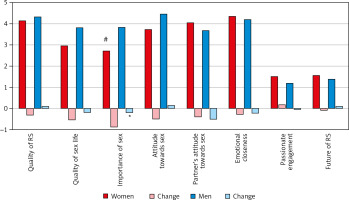
Fig. 2
Changes in sexual behaviour and satisfaction in women and their partners – part 2
* Significant difference in D change between women and men
# Significant change after cancer treatment
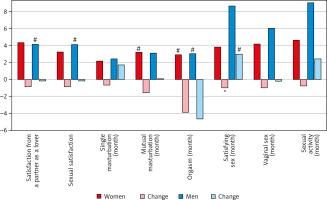
The analysis of Spearman rank correlation revealed that in women sexual function assessed by CSFQ correlated with importance of sex (r = 0.67, p = 0.001), level of avoidance of exposing one’s body during sex – based on BESAQ (r = –0.53, p = 0.01), sexual satisfaction in both domains – based on NSSS (0.82, p = 0.001 and 0.56, p = 0.01, respectively), menopausal symptoms (r = –0.44, p = 0.03), self-realization in relationship (0.66, p = 0.001), and being positive-schematic (0.65, p = 0.001). No correlation was found between marital status (r = 0.29, p = 0.17), duration of relationship (r = 0.22, p = 0.33), presence of depressive symptoms (r = –0.11, p = 0.62), anxiety (r = –0.29, p = 0.17), and sexual function. In partners, sexual function correlated with excitatory tone (r = 0.47, p=0.04) and sexual satisfaction – self-concentrated domain based on NSSS (r = 0.48, p = 0.02). No correlation was found between presence of depressive symptoms (r = –0.14, p = 0.56), anxiety (r = –0.01, p = 0.96), and sexual function.
Discussion
General remarks
There are some major strengths of this paper. Firstly, to our knowledge, this is one of the first studies evaluating sexual function and body perception in gynaecological cancer survivors and their partners. Secondly, this is one of the first studies assessing proneness to sexual stimuli in cancer survivors and their partners, as well as evaluating sexual self-concept in those survivors. Thirdly, this is one of the few papers to use strict DSM-5 criteria for assessing sexual dysfunction in women after cancer treatment, and in their male partners. Fourthly, this is one of very few studies from Poland regarding sexual function – the latest was recently published by Opławski et al. showing (by using satisfaction with life scale and sexual satisfaction scale) a deterioration of sexual function in ovarian cancer patients that did not markedly improve over time after surgery or surgery plus chemotherapy [14]. That paper, however, did not assess couple’s sexuality. Finally, this is one of few studies directly assessing the male partners’ sexual function and comparing sexual needs, perception, and expectations within the couple. Despite those strengths, it must be underlined that this is a pilot study aimed mostly at identifying areas for further investigation that will help to establish tailored sexual rehabilitation for couples including gynaecological cancer survivors. Further studies are essential to confirm this preliminary finding.
General tendencies
The results of this pilot study were surprising. The prevalence of sexual dysfunction diagnosed by DSM-5 criteria in both partners was not much higher than in the healthy age-matched population in Poland [49]. Subjective arousal and desire in women were lower after cancer, but orgasm sensation did not change, with a significant decrease in its frequency. The importance of sex decreased in both woman and their partners, but the down-change was higher in women who perceived sex to be less importance after cancer. Satisfaction from sex life did not change, in contrast to a resent study from Poland on ovarian cancer patients in which sexual satisfaction gradually decreased over time after the treatment (cytoreduction followed by chemotherapy) [14]. Surprisingly, in women the frequency of satisfying sex decreased after treatment, whereas in their partners it increased. No changes in perception of the relationship were noted. Women after cancer reported less vaginal sex and mutual masturbation whereas their male partners engaged more frequently in solo masturbation. Self-perception of body and self-attitudes did not change after cancer, but the level of avoidance of exposing one’s body during sex due to body dissatisfaction or concerns was higher compared to healthy controls from previous studies [37]. The inhibitory tone was higher compared to excitation in both partners. A more in-depth discussion of the results can be found below.
Sexual activity
According to the results of this study, 27% of survivors had not had vaginal sex at least 6 months post treatment completion. Those women presented as sexually activity by means of cuddling with their partner. This data is in line with the latest study from French oncological centres, in which 30% of patients after pelvis irradiation due to gynaecological cancer became sexually inactive [50], and with a Norwegian sample in which 4 in 10 women after treatment of cervical cancer never restarted vaginal sex [51]. However, the rate of sexually active females after the treatment varies from 56 to 90%, mostly dependent on the type of cancer, time after intervention, and the age of the women (higher rate in younger women) [8, 52–54].
Sexual problems
The frequency of sexual problems assessed by questionnaire (57%), subjective evaluation (50%), and distress (50%) was high compared to healthy subjects from a recent paper by Nowosielski et al. (30%, 31%, and 20%, respectively – similar age group) [49]. That observation is in line with other studies showing an increase in the prevalence of sexual problems in cancer survivors [50, 54–56]. Similarly, Perz et al. showed analogue scores in women after cancer treatment when using CSFQ [21]. However, in a recent paper by Buckingham et al., no changes were noticed in sexual function in a 5-year follow-up study comparing endometrial cancer with those undergoing hysterectomy for non-oncological reasons [57]. In male partners the frequencies were much higher (up to 90%) compared to heathy subjects (up to 50%, depending on the dysfunction in the population of Polish men) [43]. However, in a subjective evaluation, in most men no differences in sexual responses were noted or improvement was reported. Similarly in women, despite some changes in sexual response, the general quality of sexual life did not change, or it improved. It can be speculated that partner support or understanding might work as protection, facilitating the defence mechanism and protecting against the development of FSD, as shown in papers by Nowosielski et al. [23, 49].
Sexual dysfunction
Only 2 studies have evaluated FSD by DSM-5 criteria. In a study by Lin et al. from Taiwan, 43.7% of women had FSD: 70% – FSIAD, 20% – FOD, and 60% – GPPPD, with the lowest risk of dysfunction in endometrial cancer (no radiation, no extensive treatment) [58]. In a study by Chou et al. 43.7%, 65%, 55%, and 95%, respectively, had FSD, with a positive association between dysfunction and ovarian cancer (p = 0.05) and hormone use (p = 0.037), and a negative association with endometrial and cervical cancer (p = 0.008) [6]. In our sample the prevalence of FSD was much lower and comparable to that observed in an age-matched healthy population (20.0% vs. 14.8%, respectively) [49]. The difference might be explained by the different ages of respondents – (mean age 52 years in our study and 42 in the Lin and Chou study), where younger survivors reported higher numbers and greater intensity of sexual problems in comparison with older women [53, 59].
Frequency of sexual activity
A shift towards less oral sex and less mutual masturbation was seen. Some differences were observed between women and men – an increase in the frequency of solo masturbation in the partners and a decrease in mutual masturbation in couples. However, we did not observe a decrease of frequency of sexual activities, as observed in a study by Guntupalli et al.: a decrease of 6.1–2.6 times/month after treatment [53].
Relationship quality and importance of sex
In a recent metanalysis it was shown that for 58–79% of gynaecological cancer survivors, sex was very or somewhat important [7, 21]. In our study the importance of sex decreased in women but did not change in men. The level of interest was much lower compared to healthy subjects (2.7 vs. 3.3, respectively) [49]. Interestingly, satisfaction from sexual life and sexual partner did not change in women but significantly deteriorated in their partners. In contrast, relationship quality did not change but somehow improved, which was also noted by Logue et al.: 75–81.5% of women declared feeling closer to their partner after the diagnosis [7]. In contrast, Guntupalli et al. noted that 27% of women experienced marital dysfunction [53]. Finally, the scores in the WMRQ were in the normative range for the population of Polish healthy women, indicating a good general quality of relationship [44, 49].
Sexual inhibition and excitation
The results of this study showed high scores in sexual inhibition and low in excitation in both partners. Opposite proportions have been previously described in general healthy controls in similar age groups where excitatory tone was higher than sexual inhibition; in healthy men SES and SIS were 2.55 and 2.41, respectively [43], and for women: 2.80 and 2.63, respectively [44]. However, in survivors neither SIS nor SES correlated with sexual function assessed by CSFQ, in contrast to male partners, in whom a strong correlation was seen with excitatory tone. That might be an area for further observation and possible intervention (education to lower inhibitory tone combined with pharmacotherapy to lower sexual anxiety).
Body image and self-concept
Body image disturbances in cancer survivors might be due to scares, ostomy formation, or “loss of femineity” as a result of removal of uterus and ovaries [20]. High scores in the BESAQ indicated a more avoidant and anxious approach during sexual activity compared to healthy controls (1.36 vs. 1.25, respectively, for Polish validation study [37] and 1.3 for heathy perimenopausal women [49]). Similarly, poorer body image was noted in breast cancer survivors [23] in 2 recent studies: by Vos et al., in which 31% felt their body changed negatively and 62% – less attractive [52], and Logue et al., in which alterations were observed in 30–50% ovarian cancer survivors, whereas 75% felt less sexually attractive [7]. Additionally, a recent study by Michael et al. showed that body image disruption correlated with higher sexual distress (β = 0.23, p = 0.024) but not with sexual satisfaction (β = –0.19, p = 0.089), concluding that different psycho-sexual correlates shape sexual distress and satisfaction [26]. We have, however, shown that in survivors sexual function correlates with avoidance of exposing one’s body during sex due to body dissatisfaction based on the BESAQ (r = –0.53, p = 0.01). That area needs further studies on larger samples.
The evaluation of sexual self-concept revealed a high proportion of positive-schematic and co-schematic women. It must be recognized that sexual self-concept that reflects “one’s cognitive view or thoughts about sexual aspects of oneself” [25] might change after gynaecological cancer treatment (uterus, cervix, ovaries removal, vaginal narrowing), which may interfere with the sexual response cycle and cause alterations in perceiving one’s body as feminine. That is important because the results of the latest studies by Lin et al. showed that positive sexual self-schema correlates with better sexual function in cancer survivors (β = 0.22, p < 0.05) [60]. Why such a large, compared to healthy controls, proportion of positive and co-schematic women was shown in our study (28.2% vs. 46.7% and 22.9 vs. 40.0%, respectively) [46] needs further investigation. It would also be interesting to compare self-concepts between survivors and their partners. However, currently there is no Polish validation of the SSSS scale for men.
Implications for practice and future research
The results of this pilot study identified some areas that need further investigation: the level of avoidance of exposing one’s body during sex, sexual inhibitory tone, importance of sex, sexual self-schema, and differences in sexual activities between a woman and her partner. Those areas should be explored in further prospective studies aiming to enhance sexual performance and a positive attituded to sex in both the woman and her partner. That would allow us to tailor couple-based psychosexual intervention and incorporate this in the rehabilitation process.
Limitations
The study has also some limitations. Firstly, the study sample is too small to make a definitive conclusion. However, some general tendencies and areas for further investigation were identified. Secondly, the study is retrospective and cannot show the changes of all parameters with time after treatment. Finally, the analysis should consider different types of cancer separately, because sexual function might be different in those cancers [61]; this was impossible due to the small number of subjects. However, it has to be underlined that this is a pilot study, and thus specific interactions will be evaluated in future prospective research.
Conclusions
Some differences in perception of sexual function, needs, satisfaction, and sexual activity between cancer survivors and their partner exists. The cancer treatment changes the diversity of sexual behaviours within the couple. A tendency to avoid exposing one’s body during sex and a sexual inhibitory tone are high in both partners. Thus, in gynaecological cancer survivors with their sexual partners, both should be carefully counselled before, during, and after cancer treatment.









